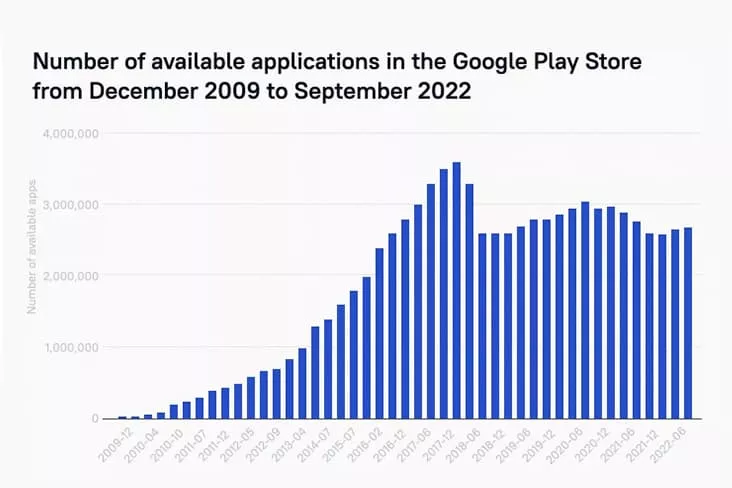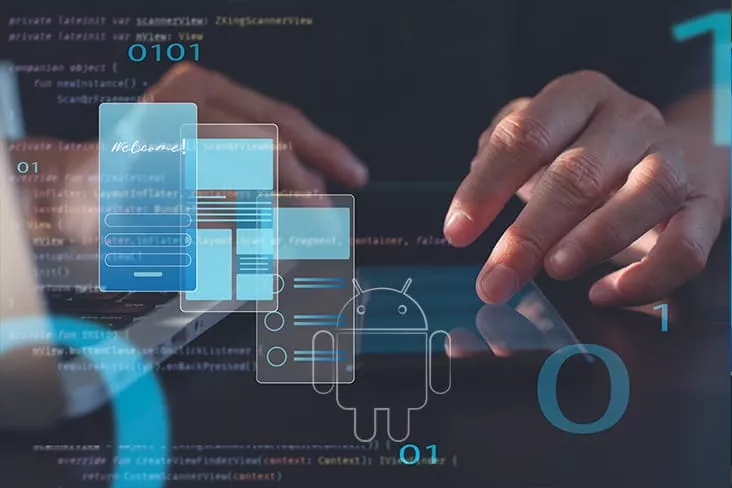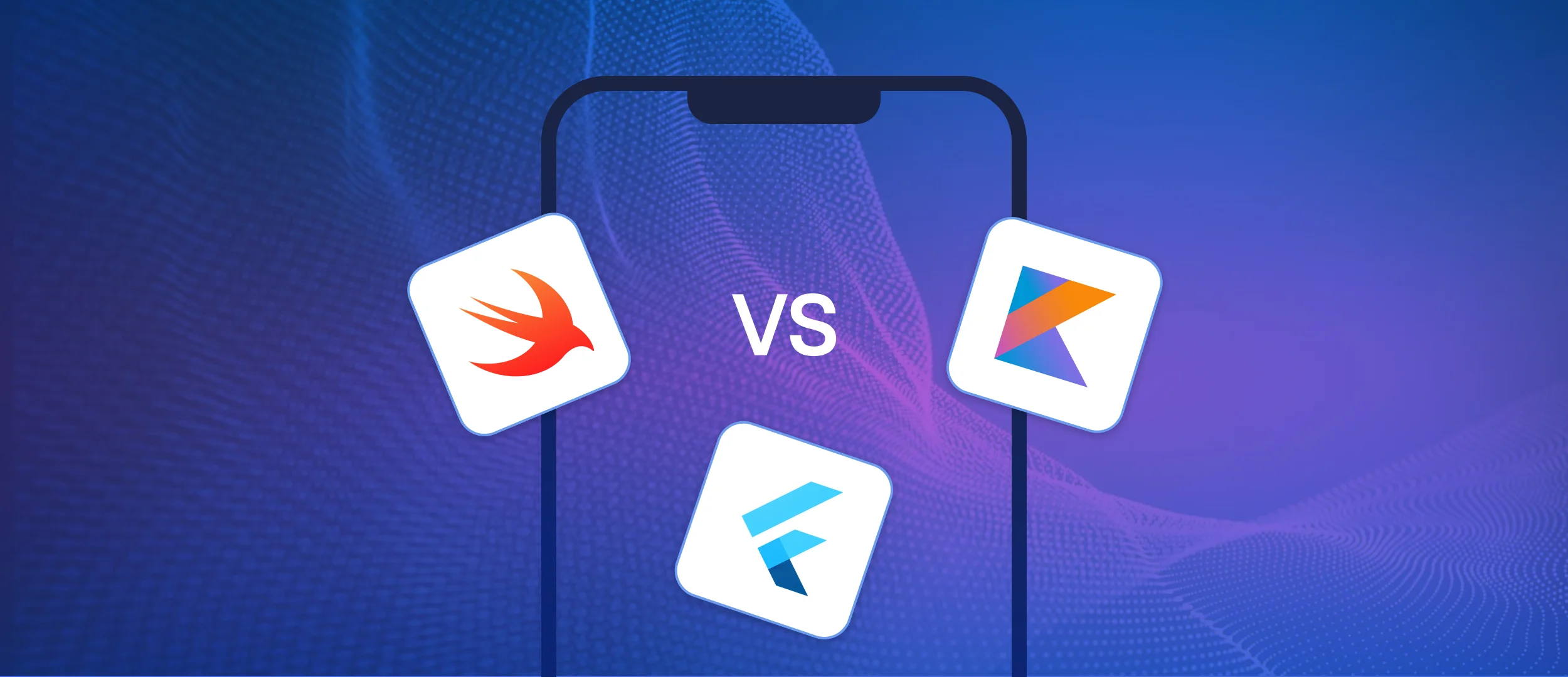
Android is still the top choice when it comes to operating systems for cell phones across the globe. In this blog post, we guide you through all stages of the Android app creation process – from idea to deployments. In just a few minutes you’ll know how to create an Android application and how to get a viable product in the end.
Ultimate Guide to Android Development
The popularity of Android applications is growing every year and brings more and more profit to their owners. For example, according to Sensor Tower, in 2020, Google Play revenue grew by 30% compared to the previous year.
Creating a custom app for Android isn’t an easy task, because it is crucial to know a few things.
There are various tools for Android developers, for example, 9 Patch, a markup scheme that allows you to set rules for stretching an image when it is resized. Without it, it is difficult to develop android applications and correctly display, including background images, due to the spread in screen sizes.
Want a web app that does more?
Let's build a solution that's smart, sleek, and powerful.
Alina
Client Manager

There is a wide range of types of Android operating systems installed by users. This gives rise to many problems when creating mobile applications for Android devices from scratch:

- During the app-building process, it is necessary to take into account the peculiarities of displaying the interface on different versions of the OS. For example, system controls may look completely different on multiple Android versions and skins of the same Android version;
- Different versions in several moments have different logic from each other. For example, before version 6.0, apps didn’t have to request each permission separately (access to the camera, microphone, and so on), they were listed in Google Play and it was assumed that the user was familiar with them before downloading. Starting with 6.0, each permission must be requested separately when the application runs. Accordingly, if you do not implement both logic options when developing an Android mobile app, it will not work either before version 6.0 or later;
- Software methods and libraries change: some of them are considered obsolete and need to be replaced with newer ones. Thus, there is always a choice: either to support the most recent OS features or to allow as many users as possible to install a mobile application;
- In the latest types of OS, multitasking in the workspace has been added. The user can display several applications on the workspace simultaneously, and yours can be allocated a completely arbitrary area in size. This should also be taken into account when creating apps.
How Much Does it Cost to Create an App?
You can develop an app for $2,000, or upwards of $2 million.
The cost of creating an app is based on a variety of factors. The type of application you are developing, the features, and the tech method you apply, significantly impact the costs.
An app development platform is cheaper than coding. Senior developers in the US charge $150 per hour, while a Junior developer from Europe might cost $30 per hour.
With adding features, and complexity to the application the cost will rise.

Mobile App Development Strategy
Android app development starts with a strategy. It defines all concepts and the future of your application.
When you are creating a mobile app development strategy there are some issues. You can’t simply make apps because your competitors do. Competitors can have different from your business objectives and they are not suitable for you.
There are 4 stages of developing a mobile app strategy:
- Understanding the business strategy
- Business mobile app strategy
- App Strategy
- Product management strategy
Understanding the Business Strategy
Understanding the business strategy is the basis of your app development. The difference between the company strategy and the app strategy might be irreparable.
There are advantages to creating a mobile strategy that’s linked to the company strategy.
- Maximizes ROI
- Leads to client satisfaction
- Reduces training needs
- Decreases integration requirements and bugs
- Improves quality, value, employee efficiency, and client engagement
- Aligns target to goals
A good mobile strategy is the touchpoint of business goals, mobile opportunities, and clients' needs.
Business Mobile App Strategy
App strategy is your way to achieving success with development and marketing. It will be easy to build if you can answer to questions:
- What is the main purpose of the app?
- What is the advantage that the customer will get using the app?
The strategy must be relevant, measurable, achievable, and on time. Everything unachievable must be eliminated. For example, having more downloads than Telegram isn’t an achievable goal.
Create a Roadmap
You should break the app idea into elements that will be executed in various timelines as a step towards building a great mobile strategy. It is known as a roadmap. Tools like this will make the process much easier.
The app strategy is going to be distributed into tasks that are shown visually. in the roadmap, you will find out how much time is needed, who is the executive for the task, and how tasks to interlink.
Budget
When you are creating a mobile app development strategy, whether for eCommerce or to develop a taxi app, there are some issues. The cost of mobile app development, and your budget, will determine how fast it can be created and launched. The budget includes operating costs, capital, staff, and other resources.
App resources and budget planning are linked directly to the company’s budget, and the budget s linked to the roadmap.
If you want to develop the app instantly, you should increase the budget and take more resources, but it can only be done if your company has available resources.
Defining the App Strategy
It is time to define the case of use accordingly to the customer journey. This needs a clear definition of the app strategy.
A case of use is at the heart of defining application strategy. It’s the list of actions that define the link between a role and the system.
The use case involves several things such as the happy path, the intent of the use case, alternate action paths, and testable actions.
Deciding which use case is the first stage of defining the application strategy.
Target Audience
You must understand who will use your application, and which type of customers.
What are your customer's needs, age, gender, location, etc?
The reality is that you can’t build a mobile app for all customers. The simple way is to develop an app for 80% of users.
The best method to define the TA is to use buyer personas. It helps you define your target audience. Personas will help to categorize and group TA.
Define Key Performance Indicators
Stakeholders often ask what value the application gives to the business.
Defining KPIs for the application will help monitor the performance. Also, it will help set timely goals for the app to achieve.
You have to link the app performance metrics with the company’s KPIs.
If revenue, cost reduction, and market share are the metrics for your business, then the KPIs must lead to one of the company's KPIs, so the app will add value.
The most important app performance metric is the number of new users. Other metrics are an increase in usage and sessions, active users, downloads app rating, repeat customers, customer retention, session length, and customer lifetime value.

Product Management Implementation Strategy
As you defined and documented the mobile app strategy, it’s time for implementation.
Defining MVP
Implementing starts with the definition of the minimum viable product. MVP is the product with the minimum features for validating purposes.
Instead of implementing all the features at once, you should choose priority features, starting from the minimum acceptable features.
For minimum viable product list all the possible features for your application, choose priority features and add must-have features in the first version. The remaining features should be added over a few years.
Testing strategy
You will need to test your application because there might be bugs.
You won't fix all the bugs, but you can decrease issues by building a workable testing strategy.
The testing strategy must be understood before the developers get to work. The testing strategy must include:
- The scope of the application
- What scope doesn't include
- The features
- Individual cases
- Result
- Application versions and integration
Basic App Development Process
Mobile app development strategy is an in-house process while the app development process can be outsourced.
The app development process consists of stages:
- Setting the scope
- User/market research
- UX wireframe
- Prototype
- UI design
- Animation
- Software architecture
- iOS development
- Testing
- Release
Setting the scope
The scope means the work that needs to be done, the app's goal, and how large/small it has to be. The scope includes:
- The essence of the app
- TA
- Most important features of the app
- Visual design features
- Linking with the business strategy
- Potential technologies to be used
- Specific preferences
To document the scope of the app, it’s very important to identify all of the following:
- Objectives and goals of the app
- Stages and substages
- Tasks and resources
- Budget
- Schedule
The design and flow of the app will be prepared based on the scope.
User/Market research
This is the stage where the UX and UI designers will start working based on the scope. It includes market research and user research.
The designers should come up with a custom UX design that will help your app to be on the top.
You should start with in-depth market research and analyze the competitors.
The user research will show colors and themes that will help you develop an emotional connection with TA.
What colors and styles will the end-users prefer? You can collect data from the potential users by asking for focus groups, design workshops, etc.

UX Wireframe
The visual appeal of the user interface is the UX wireframe. You should build a structure of the user interface, transitions, and interactions. It will be based on research, competition, and strategy.
You can use specialized software or you can design a simple outline on paper as you want it to be shown on the actual app.
The aim of the mobile app UX design process is to see the flow of the app such as the number of buttons, where buttons lead the user, the registration process, the login screen, and everything that includes the front end of your app.
Create a prototype
The prototype gives you the possibility to see the app. You have to develop it as soon as possible. Once you have the UX wireframe, building a low-fidelity prototype is a simple task. The low-fidelity prototype is the sketch prototype. You don't need to waste money on the high-fidelity prototype.
A simple prototype will visually represent the app's look. Experts recommend using low-fidelity prototypes to save money and time.
UI Design
The UX research, wireframing, and prototyping show how the app works, and the UI design shows how the app looks.
After testing the UX, several prototypes testing, and finalizing, it is time for a mobile app UI design process.
Here you deal with visual concepts, color schemes, fonts, shapes, buttons, font size, images, forms, illustrations, animation, etc.
You need to test various designs to see what suits you best for users. All the visual elements have to be tested several times to find out what is the best.
Interface Animation
In the UI design stage, the animation and its different styles should be tested.
It is the user interface animation when new screen pop out and how gestures are defined, etc.
Interface animation grabs user attention, as pointed out in Google’s material design principles:
“Motion design can effectively guide the user’s attention in ways that both inform and delight. Use motion to smoothly transport users between navigational contexts, explain changes in the arrangement of elements on a screen, and reinforce element hierarchy.”
The animation must be functional and not a simple design feature.
Software Architecture Planning
This is the most important part of the development process. Software architecture planning is about scaling the application and making its functionality and design better.
Software architecture planning is parallel to designing.
The entire team work with the designers, developers, and managers. The concept is to make better the Front-end and the Back-end development processes by tweaking the software architecture.
Architecture planning aims to define a structured solution with all requirements: technical, operational, business, user, and system.
App Development
This is the stage where programming begins and the coders start building the app. The app can be created for Android or iPhone apps or both. You shouldn't develop an app for both platforms, the better method is to build the application for one platform first.
Why? Creating the application for a single platform from a specialist will cost you thousands of dollars. If it is poorly coded, it will be a failure. It is better to choose Android app development first since it costs less as compared to iOS.
Testing
If the average failure rate for application testing for Android is 16.4%, it is time to launch your freshly developed app for testing.
The aim of testing the application is to find bugs and ensure that the works as properly. There are several phases of testing and you should test for all these stages.
- Functional testing
- Memory testing
- Performance test
- Security test
- Interruption test
- Usability test
The application can be tested in-house or outsourced.
Release
Now it’s time for releasing your app after it has passed the testing stage.
You need to submit your app to the appropriate app store. It will take up to a week to be approved, so plan your release time accordingly.
Conclusion
The app development process can be divided into several phases. The number of steps in the application development process will differ, depending on how you group different tasks.
Mobile app design and development processes come close to each other.
Design plays an important role in the success of an application, which is why it’s crucial to allocate time, resources, and effort to designing your app.
Before you roll out the application to the public,a mobile application development company can help you test it and eliminate all found bugs and errors in the logic. It is best to involve a focus group - people from the outside who fit the description of the target audience and are still unfamiliar with the project.
If you want to create an app for Android that would help and enrich your business choose Stfalcon we have the relevant experience. Depending on the complexity of the application and the size of the budget, we will choose the most suitable development technologies and will create the top app for your business.
About the Author
Andrii is an Android developer with more than 6 years of experience in building, integrating, and maintaining Android apps. He has a strong background in the development of enterprise-level software and applications. As a writer, he wrote numerous articles on app development. Currently, he is working with the Stfalcon team.



